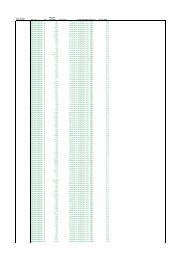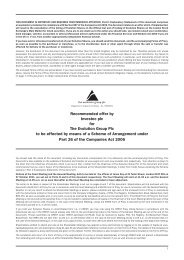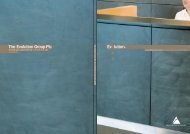Annual Report for the year ended 31 December 2008
Annual Report for the year ended 31 December 2008
Annual Report for the year ended 31 December 2008
You also want an ePaper? Increase the reach of your titles
YUMPU automatically turns print PDFs into web optimized ePapers that Google loves.
1. aCCoUntinG PoliCies (CONTINuED)<br />
Measurement of available-<strong>for</strong>-sale financial assets<br />
For available-<strong>for</strong>-sale financial assets that are quoted in active markets,<br />
fair values are determined by reference to <strong>the</strong> current quoted bid/offer<br />
price. Where independent prices are not available, fair values may be<br />
determined using valuation techniques with reference to observable market<br />
data. These may include comparison to similar instruments where market<br />
observable prices exist, discounted cash flow analysis, option pricing models<br />
such as Black-scholes and o<strong>the</strong>r valuation techniques commonly used by<br />
market participants.<br />
The management of <strong>the</strong> company makes an assessment at each Balance<br />
sheet date as to whe<strong>the</strong>r <strong>the</strong>re is any objective evidence of impairment,<br />
being any circumstance where an adverse impact on estimated future cash<br />
flows of <strong>the</strong> financial asset or group of assets can be reliably estimated.<br />
in <strong>the</strong> case of equity investments classified as available-<strong>for</strong>-sale, <strong>the</strong><br />
cumulative loss (measured as <strong>the</strong> difference between <strong>the</strong> acquisition cost<br />
and <strong>the</strong> current fair value, less any impairment loss on that financial asset<br />
previously recognised in <strong>the</strong> income statement) is removed from equity and<br />
recognised in <strong>the</strong> income statement. impairment losses recognised in <strong>the</strong><br />
income statement on available-<strong>for</strong>-sale equity investments are not reversed<br />
through <strong>the</strong> income statement.<br />
Trade and o<strong>the</strong>r receivables<br />
Trade and o<strong>the</strong>r receivables (which include counterparty receivables) are<br />
recognised initially at fair value and subsequently measured at amortised<br />
cost using <strong>the</strong> effective interest method, less provision <strong>for</strong> impairment.<br />
A provision <strong>for</strong> impairment of trade receivables is established when <strong>the</strong>re<br />
is objective evidence that <strong>the</strong> Group will not be able to collect all amounts<br />
due according to <strong>the</strong> original terms of <strong>the</strong> receivables. evidence that an<br />
impairment of <strong>the</strong> asset may be required include ageing of <strong>the</strong> debt beyond<br />
180 days, persistent lack of communication and internal awareness of third<br />
party trading difficulties.<br />
The amount of <strong>the</strong> provision is <strong>the</strong> difference between <strong>the</strong> asset’s carrying<br />
amount and <strong>the</strong> present value of estimated future cash flows, discounted at<br />
<strong>the</strong> effective interest rate. The amount of <strong>the</strong> provision is recognised in <strong>the</strong><br />
income statement within operating expenses.<br />
Cash and cash equivalents<br />
For <strong>the</strong> purposes of <strong>the</strong> cash flow statement, cash and cash equivalents<br />
include cash in hand, deposits held at call with banks, and o<strong>the</strong>r short-term<br />
highly liquid investments that are readily convertible to known amounts of<br />
cash and which are subject to an insignificant risk of change in value. such<br />
investments are normally those with original maturities of three months or<br />
less. Bank overdrafts are shown within borrowings in current liabilities on<br />
<strong>the</strong> Balance sheet.<br />
notes to tHe FinanCial statements CONTINuED<br />
FOR THE YEAR ENDED <strong>31</strong> DECEMBER <strong>2008</strong><br />
Trade and o<strong>the</strong>r payables<br />
Trade and o<strong>the</strong>r payables are recognised initially at fair value, which is<br />
<strong>the</strong> agreed market price at <strong>the</strong> time goods or services are provided. The<br />
company accrues <strong>for</strong> all goods and services consumed but yet unbilled<br />
at amounts representing management’s best estimate of fair value.<br />
Evolution Group employees share trust<br />
The Trust is a separately administered trust, which is funded by loans<br />
from <strong>the</strong> company, and <strong>the</strong> assets of which comprise shares in <strong>the</strong><br />
company. The company recognises <strong>the</strong> assets and liabilities of <strong>the</strong> Trust<br />
in its Financial statements and shares held by <strong>the</strong> Trust are recorded at cost<br />
as a deduction in arriving at shareholders’ funds until <strong>the</strong> shares vest<br />
unconditionally with employees.<br />
iAs 39 has a scope <strong>for</strong> exclusion of treasury share transactions linked to<br />
share-based payment awards. The Trust is considered to act as an agent <strong>for</strong><br />
<strong>the</strong> company, and accordingly aggregation of <strong>the</strong> Trust’s assets and<br />
liabilities to reflect <strong>the</strong> substance of <strong>the</strong> relationship.<br />
Group Recharge<br />
The company, through <strong>the</strong> normal course of business, incurs costs on<br />
behalf of its subsidiaries. These costs are recharged, where relevant,<br />
to those subsidiaries.<br />
The company recharges it subsidiaries <strong>for</strong> cash <strong>for</strong> <strong>the</strong> cost of share<br />
options. The amount of <strong>the</strong> recharge is equivalent to <strong>the</strong> cost of shares<br />
purchased by <strong>the</strong> company to satisfy <strong>the</strong> awards made to subsidiary<br />
employees under <strong>the</strong> Group’s employee share scheme. This recharge<br />
reduces <strong>the</strong> investment in subsidiary and a corresponding entry is made<br />
to increase retained earnings.<br />
Employee benefits<br />
(a) Pension obligations<br />
The company does not offer any company pension schemes. however, <strong>the</strong><br />
company does make defined contributions to employees’ approved personal<br />
pension plans, and <strong>the</strong> costs of <strong>the</strong>se are charged to <strong>the</strong> income statement<br />
when <strong>the</strong>y are incurred.<br />
(b) Share-based plans<br />
The company’s management awards high-per<strong>for</strong>ming employees bonuses<br />
in <strong>the</strong> <strong>for</strong>m of equity-settled share based payments, from time to time,<br />
on a discretionary basis. in accordance with iFrs 2, ‘share-based<br />
payments’, equity-settled share-based payments are measured at fair value<br />
at <strong>the</strong> date of grant. Fair value is measured by use of <strong>the</strong> Black-scholes<br />
pricing model or, in <strong>the</strong> case of awards of call rights, which have an exercise<br />
price of 1p per ordinary share; <strong>the</strong> fair value is based on <strong>the</strong> market value at<br />
<strong>the</strong> time of grant discounted by <strong>the</strong> dividend yield over <strong>the</strong> expected life. The<br />
fair value determined at <strong>the</strong> grant date of <strong>the</strong> equity-settled share-based<br />
payment is expensed on a straight-line basis over <strong>the</strong> vesting period, based<br />
on <strong>the</strong> company’s estimate of <strong>the</strong> number of shares, which will eventually<br />
vest. The options are generally subject to a three <strong>year</strong> service vesting<br />
condition, and <strong>the</strong>ir fair value is recognised as an employee benefits<br />
expense with a corresponding increase in equity over <strong>the</strong> vesting period.<br />
The proceeds received net of any directly attributable transaction costs are<br />
credited to share capital (nominal value) and share premium when <strong>the</strong><br />
options are exercised.<br />
83






![2. Front continued [c87307] - The Evolution Group PLC](https://img.yumpu.com/19604468/1/184x260/2-front-continued-c87307-the-evolution-group-plc.jpg?quality=85)


